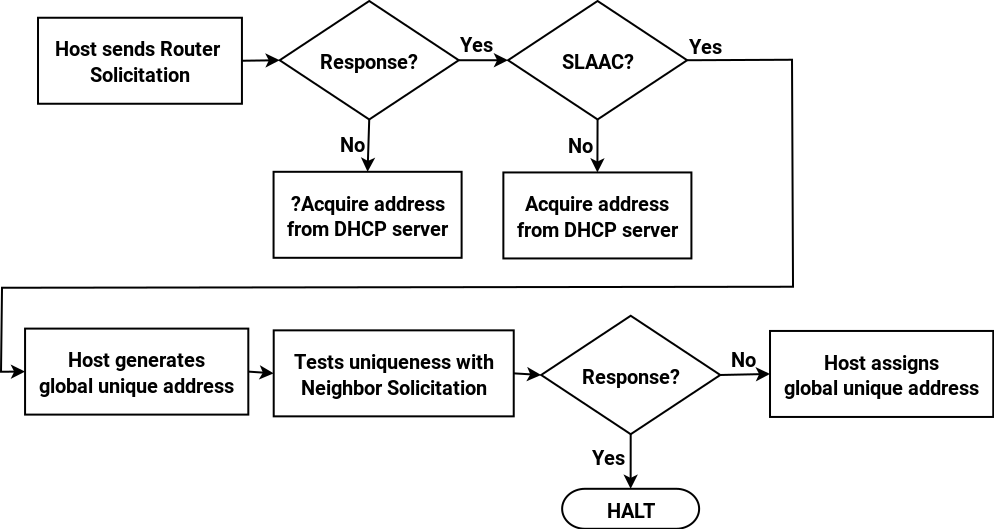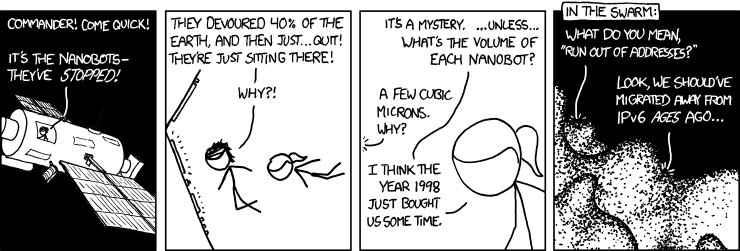One of the most common objections to NAPT is that NAPT devices maintain state, and that this violates the “end-to-end principle” (see for example Tom Coffeen’s book IPv6 Address Planning: Designing an Address Plan for the Future, chapter 1).
Now the end-to-end principle is fundamental to the architecture of the Internet. It owes a lot to the work of Louis Pouzin on the CYCLADES network: his insight was that functions like reliability of transmission and virtual circuits were best handled at the endpoints of a connection, leaving the network to simply shift packets around, without worrying about reliability or even the order in which the packets arrived at their destination. You might summarise this as “smart hosts, dumb networks”. To illustrate this, let’s imagine a set of ping-pong balls that spell out the word “hello”. If I drop them through a wooden box that splits them up and sends them through different paths before they fall out of the bottom (a bit like a bean machine only outputting a single sequence of balls), then I might end up with a set that says “loleh”. I would then put them back in the correct order (perhaps by using a sequence number on the back of each ball). If the box lost a ball I would arrange for retransmission of the lost ball. That’s basically how TCP/IP creates virtual connections over an unreliable datagram network.
The end-to-end principle has been very important in allowing the Internet to scale up to the size it is today: routers are (relatively) simple devices that can be added into the network to form a mesh, through which individual datagrams (the segments of a conversation) can take various paths to their destination. Crucially it has also made the Internet much more robust: if there is a problem at any point in the path between two hosts, then datagrams can route themselves around the obstacle and find an alternative path.
To quote RFC 1958:
This principle has important consequences if we require applications to survive partial network failures. An end-to-end protocol design should not rely on the maintenance of state (i.e. information about the state of the end-to-end communication) inside the network. Such state should be maintained only in the endpoints, in such a way that the state can only be destroyed when the endpoint itself breaks (known as fate-sharing). An immediate consequence of this is that datagrams are better than classical virtual circuits. The network’s job is to transmit datagrams as efficiently and flexibly as possible. Everything else should be done at the fringes.
If a particular node or set of nodes on a link has to maintain the state of the connection, then datagrams can’t route themselves round trouble. However this argument only really applies in the Default-Free Zone (DFZ), the meshed heart of the Internet where there is no default route and datagrams have a multiplicity of routes to their destination. Stub networks in general (and enterprise networks in particular) are more like the branch of a tree than a mesh: there is generally only one well-defined path out to the Internet. That path out to the Internet typically goes through an NAPT device; if that NAPT device fails, then packets have no alternative path to take anyway.
Now it’s true that if the link to the Internet went through a stateless device then it could fail and then recover, and the endpoints could continue their conversation where they had been interrupted, assuming that the application hadn’t timed out in the meantime. When a NAPT device fails and then recovers then the NAPT state has been lost and all the connections going through that device are broken (this assumes that the NAPT device is not clustered in a way that maintains NAPT state during a failover). However, this argument holds true of any network device that holds connection state, stateful-inspection firewalls for example, although the anti-NATters rarely make this explicit.
In fact (at the enterprise level at least) NAPT devices are nearly always stateful-inspection firewalls as well. The anti-NAPT argument often refers to the performance overhead of maintaining NAPT state, but stateful-inspection firewalls have to maintain the state of permitted connections anyway, and it would surprise me if the internal architecture didn’t combine the two functions. The whole point of stateful-inspection firewalls is that they improve performance, by avoiding the need to test every datagram against the firewall’s ruleset.
In reality there are many stateful network devices at the modern enterprise perimeter: not just firewalls/NAPT devices, but intrusion prevention systems, web proxies, load balancers and other reverse proxies. They all violate the end-to-end principle, and they all have to devote resources to maintaining state, but the security and performance benefits that they provide outweigh the loss of resilience. It’s a pragmatic compromise: architectural principles are fine as long as you don’t lose sight of the bigger picture.
In the next post I’ll look at the impact of NAT on applications.




